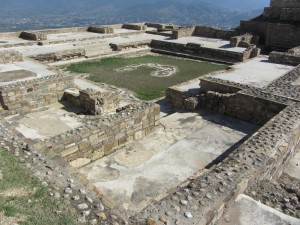On this page we are assembling resources relating to our excursion to the archaeological site of Atzompa. (Under construction; if you wish to print, please wait until closer to the start of the Institute.)
Atzompa was a satellite of nearby Monte Albán, also occupied by Zapotecs. It was founded between 650 C.E. and 850 C.E. (Classic Period). Artifacts show that the occupants of Atzompa traded with people as far south as what is now Guatemala and as far north as the modern state of Hidalgo, Mexico. The people of Atzompa produced pottery. The site also has a stone quarry that probably produced the stone used for building Monte Albán.
Atzompa has an extraordinary number of ball courts and two luxurious residences for the nobility, known today as the Casa de Oriente (East House) and the Casa de los Altares (House of the Altars).
One of the interesting features of this ball court is its niches, perhaps where sacred objects were stored.
Notice the geometric patterns in the wall.
Given the historic tensions between the Zapotecs and the Mixtecs, it was important to be able to monitor activity (and control agriculture) in the valley below. In this photo the valley of Etla is just visible in the distance, but from this location one truly has a grand view.
Below, we see an explanation of the ceramics traditions of ancient times and today in this region and the modern community of Atzompa. Today, the modern community of Atzompa, below the archaeological site and going toward the Valley of Etla, is a Mixtec community. It is still famous as a pottery-producing community.
Today, Atzompa is known for a type of green-glazed pottery. A few women, such as Dolores Porras and Angélica Vásquez, have also innovated in ceramics and received considerable acclaim.











